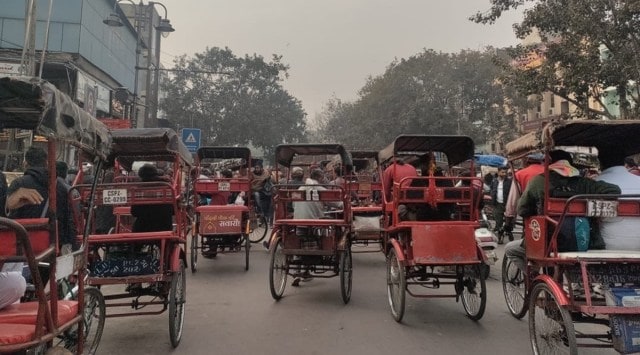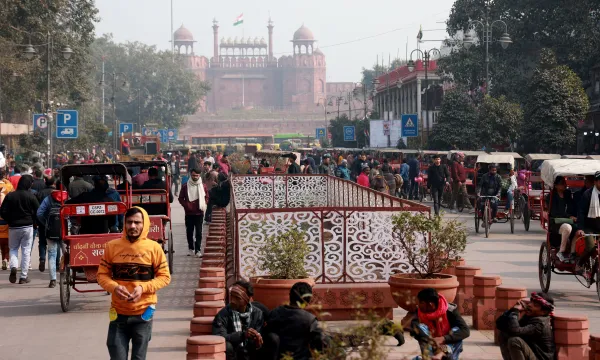More than a year after its first phase of revamp, Chandni Chowk, one of the oldest and largest markets in India, seems to have little to brag about. Many promises made remain on paper as pedestrianisation, the project’s pivotal focus, is far from reality on the 1.3 km-long stretch.
As one enters the lane, the most prominent feature between Red Fort and Fatehpuri Masjid is the plethora of cycle rickshaws – though originally envisaged as a stretch with 400 such vehicles, it is now swamped by over 1,000.

 Almost all rickshaws that ply on the route are taken on rent.
Almost all rickshaws that ply on the route are taken on rent.
Under the first phase of the project, electric cables were taken underground, dedicated lanes for non-motorised transport and walkways were constructed, and facilities such as toilets, ATMs, and benches were provided. When The Indian Express visited the stretch earlier this week, it found that the sandstone had lost its sheen, some street lamps were missing, bollards were broken, and cleanliness was questionable. At many places, sanitation staff could be seen picking after the mess left by shoppers. Signs of a second phase of the revamp were largely non-existent.
On January 4, a meeting was held to discuss preparations ahead of the G20 summit, when it was decided that only 400 rickshaws, as decided in 2021 at the time of revamp, will be allowed to operate. This is to preclude unauthorised rickshaws as radio frequency identification device (RFID) tags will act as a licence on the premises.
In reality, though, there is little to stop more rickshaws from plying on the route, which makes walking on the main path a chore and pushes pedestrians to the sidewalks – just like it used to be when vehicles were allowed to ply here.
“There are more than 1,000 rickshaws here. Many rickshaw pullers from outside also enter the market, but the employment situation is so grim that I don’t mind. People can earn more in a day here than a week outside,” said Raj Kishore Paswan, who has been pulling rickshaws for 20 years and has a licence to ply here.
Almost all rickshaws that ply on the route are taken on rent. From Sankar Thapa, who came from Nepal 12 years ago, to Sumit, who wears his licence with a tag around his neck, they all pay a fee ranging from Rs 70 to 100 a day.
Story continues below this ad
Ajijul Sek has been around Chandni Chowk for a year. He pays 100 a day as rent and gets around 50 rides on a weekday. Stationed outside Gurdwara Sis Ganj Sahib, he said regulation is necessary. “There are too many rickshaws.., If I am asked to leave, I will; it is not like I get to have a say in this,” he said.
Another problem is the continued presence of motorised vehicles on the stretch despite strict orders, and signage propped up almost every 100 metres, against it. A blue sedan could be seen going past a police patrol van, a few metres away from a signage that read, ‘Motor vehicles prohibited from 9 am to 9 pm.’ Near a small lane branching off from the main stretch, signage read ‘pedestrian crossing’, but many motorcycles thronged the area.
Chandra Kumar Singh DCP (traffic, Central and North) said, “All motorised vehicles on the stretch are challaned without fail. Though there are problems with CCTVs, we have started working with the National Informatics Centre to fix the faulty ones.”
Sanjay Bhargav, president of the Chandni Chowk Sarv Vyapar Mandal, who attended the January 4 meeting, said CCTVs in the area were not functioning, which is why many aren’t fined the Rs 20,000 for getting a vehicle in.
Story continues below this ad
“I floated the idea of introducing RFID tags a few years ago to keep a check on the proliferation of rickshaws. CP, Chandni Chowk and Khan Market are going to be revamped for G20. IIT has chalked out a plan to launch a new rickshaw, but for the time being, the current ones will stay, but only 400 of them. Boom barriers manned by police are not working; the place has descended into chaos. This regulation is inevitable,” Bhargav said.
“Before the revamped stretch was inaugurated, (now jailed AAP minister) Satyendar Jain was the chairman of the Shahjahanabad Redevelopment Corporation (SRDC), the nodal agency to execute the redevelopment of the heritage market. In September 2021, as many as 100 rickshaws were given a unique number and its pullers a set of uniforms to demarcate them from outsiders, but later the practice fell into disuse,” he added.
Rickshaw puller Imran Khan, however, said: “They gave us one set. How can we manage with one, especially in winter?”
Meanwhile, shoppers were too busy hailing rickshaws. Some, like dentistry graduate Anushree, rued the lack of space to walk. “The number (of rickshaws) should come down… People like us can roam around on foot, this set-up helps old people a lot, so it can’t be totally done away with.”
Story continues below this ad
Shubham, a regular shopper, had a different view: “There is such a humongous crowd that even the existing rickshaws are never enough to meet the demand.”
Ritu, another regular at the market, suggested introducing battery buses. “There are too many rickshaws now. Earlier, the government buses could carry a limited number of people, and the stretch was less congested,” she reminisced.
Walking amidst a long queue of rickshaws, Pramod, a civil defence volunteer, said they do their best to enforce regulations against unauthorised rickshaws. “We go around and ask those without a licence to vacate,” he said.



 Almost all rickshaws that ply on the route are taken on rent.
Almost all rickshaws that ply on the route are taken on rent.





